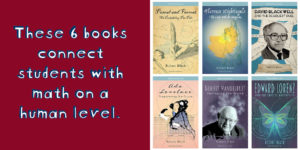Sign in for exclusive products and special discounts.
6 Mathematician Biographies for Students

The Mathematical Lives collection is a series of mathematician biographies for students written by author and former writer for Nickelodeon Robert Black. Black designed the books to teach students about the people who developed mathematical fields and formulas, showing how and why they shaped the solutions that we take for granted today.
Through mathematician biographies, we learn that the men and women who shaped mathematics were interesting people grappling with real problems, and their approaches to those problems on occasion led to new fields and new ways of thinking about math. Unfortunately, the excitement and the struggles of these people are lost in the ways we traditionally teach children about math. Here is a type of problem, we teach, and this is the formula to solve it. In that sort of teaching, the humanity that lies behind the math is obscured. These biographies shine a light on that humanity. Math is not dry and dull; it is a fascinating world of discovery and invention.
There’s even a “Doing the Math” section at the end of each book, allowing youngsters the opportunity to try out some of the math themselves!

Pascal and Fermat: The Probability Pen Pals
In the early 1650s, a French aristocrat posed a gambling question to Blaise Pascal, one of the most brilliant scientists and philosophers of the time. To figure it out, Pascal wrote to his countryman Pierre de Fermat, arguably the greatest “amateur” mathematician of all time. The two men exchanged a series of letters that laid the foundation of what we know today as probability theory.
Florence Nightingale: The Lady with the Diagrams
Florence Nightingale is known for her revolutionary impact on medicine. But what most people don’t know is that she also invented an array of circular diagrams and bar charts to explain her research on disease and death rates. The “Lady with the Lamp” can also be credited as the “Lady with the Diagrams” for pioneering a way for mathematicians and statisticians to present bare facts as intelligible truths.
David Blackwell and the Deadliest Duel
David Blackwell was an African-American working in the years before and during the Civil Rights Movement, but that didn’t seem to hold him back. Although much of his work stemmed from his study of duels, his influence stretches across a wide range of subjects, and today he is regarded as a brilliant mathematician whose contributions helped to lay the foundation for new fields such as information theory.
Ada Lovelace: Programming the Future
In 1822, Charles Babbage designed the “Analytical Engine,” which was in effect the first computer. Although the machine was never built, an editor hired Ada Lovelace to write about it. Lovelace had studied advanced mathematics, which was rare for women at that time, and she went beyond what Babbage had done, expressing breakthrough ideas that are at the foundations of modern computer science.
Benoit Mandelbrot: Reshaping the World
Benoit Mandelbrot had a talent for envisioning geometric solutions to mathematical problems, and that and his ability to find connections among seemingly unrelated subjects led him to the discovery of fractal geometry. Others took what he did and applied it to new areas, and his work was the foundation for the development of smartphone antennas, movie animation magic, and much more.
Edward Lorenz and the Chaotic Butterflies
Tiny changes in a system dramatically affecting the course of much larger events—what we know of as “the Butterfly Effect”—was demonstrated in 1960 by a mathematician and meteorologist named Edward Lorenz. It was an accidental discovery, but like the concept itself, it led to something much larger—something that has been called one of the twentieth century’s great revolutions in the physical sciences: chaos theory.
